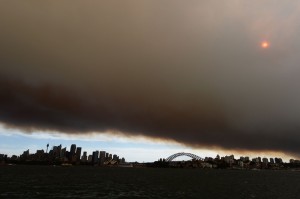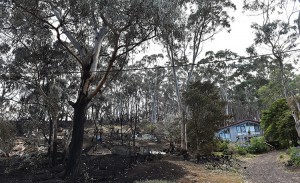Australian Firehawks
Thursday, February 1st, 2018February 1, 2018
Bird watchers in Australia were recently surprised as several species of predatory birds appeared to be spreading bushfires as a novel hunting technique. For many years, wildlife biologists have documented raptors that fly around the edges of wildfires, practicing what the scientists call “fire-foraging.” The birds pounce on small mammals and reptiles flushed from the bush by advancing flames. A new report in the Journal of Ethnobiology, however, details how birds also seem to be intentionally spreading wildfires to new, unburned areas of grassland to increase their hunting chances. The report suggests that birds, like humans, have learned to use fire both as a tool and as a weapon.

Bushfire smoke darkens Sydney in New South Wales, Australia. A recent scientific report has backed up Australia’s age-old stories of “firehawks” that spread bushfires to catch prey. Credit: © AP Photo
Bushfires are wildfires common throughout Australia due in part to the country’s hot and dry climate. Many wildfires start in the remote countryside known to Australians as the bush. Bushfires can be extremely destructive, especially if they reach urban areas. The fires damage forests and farmland and can kill animals and people and destroy property. In recent years, as global warming has helped make drought conditions worse in Australia, bushfires have been an increasing threat.
Bird watchers have long reported witnessing black kites (Milvus migrans), whistling kites (Haliastur sphenurus), and brown falcons (Falco berigora) hunting prey on the edges of wildfires. Recently, however, birds were seen picking up smoldering twigs with their beaks or talons. The birds then carried the twigs to other areas of dry bush up to a half mile (1 kilometer) away, where they dropped the sticks like lit matches, igniting a new blaze. The birds then began feasting on the animals trying to escape the new flames.

Australian “firehawks” could potentially spread bushfire damage (seen at left) to areas the fire might not naturally reach (at right). Credit: © Julian Smith, EPA/Landov
In the past, Aboriginal people in Australia also used fire to flush animals from the bush. They also say that so-called “firehawks” have been doing the same for thousands of years. The birds’ behavior is not new, then, but has been long known to local people of the Northern Territory, Western Australia, and Queensland. Firehawks are even mentioned in stories of the Dreamtime, an ancient time when the first beings existed.
Despite the dangers posed by bushfires, forest rangers in Australia regularly light controlled fires for the benefit of the environment. Small occasional fires can rid an area of underbrush. If an area goes unburned for a long time, the accumulated underbrush can fuel a much larger and more dangerous fire. However, rangers must now take into account the risks posed by raptors that may spread controlled burns into new areas where the fires could grow out of control.


